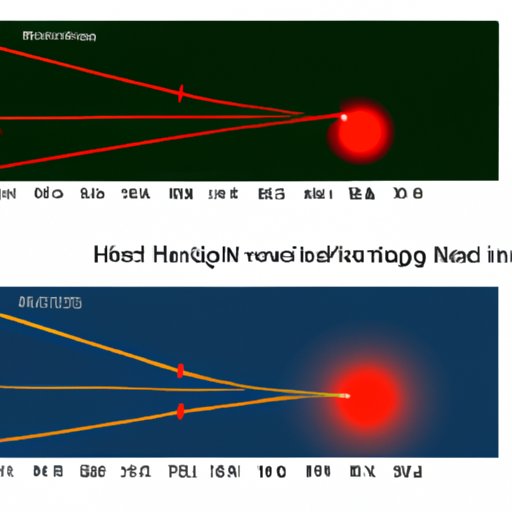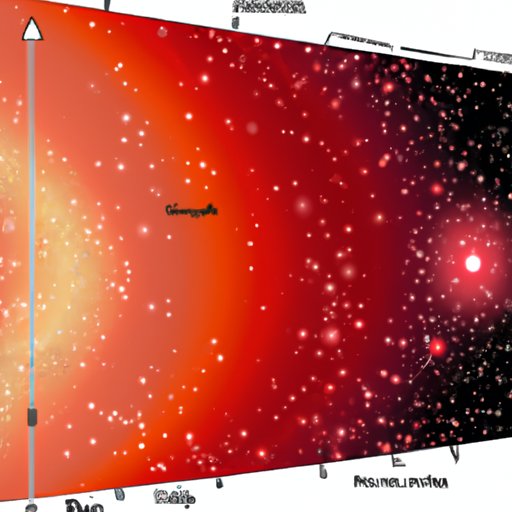Introduction
Redshift is a phenomenon in astronomy that occurs when an object is moving away from an observer. The term ‘redshift’ was first coined by astronomer Vesto Slipher in 1912 and has since become an essential tool used to understand the universe and its history. In this article, we will explore what redshift is and its importance in astronomy.

Exploring the Phenomenon of Redshift in Astronomy
When an object is moving away from us, the light waves emitted by it are stretched out, making them appear “redder” than normal. This shift in color is known as redshift. Redshift can be measured using the Doppler effect, which states that the frequency of a wave changes depending on the relative motion between the source and observer. When an object is moving away from us, the frequency of the wave decreases, resulting in a redshift. Conversely, if an object is moving towards us, the frequency increases, resulting in a blueshift.
The amount of redshift observed is related to the distance of the object. Objects that are further away will have a greater redshift, while objects that are closer will have a smaller redshift. This relationship between redshift and distance is known as the Hubble law, named after Edwin Hubble who discovered it in 1929.

A Guide to Understanding Redshift and Its Impact on the Universe
Redshift plays an important role in our understanding of the universe. By measuring the redshift of distant galaxies, astronomers are able to determine their distances, and thus map out the structure of the universe. Redshift also allows us to study the history and evolution of galaxies over time. By observing how a galaxy’s redshift changes over time, astronomers can infer information about the age and rate of star formation in the galaxy.
Redshift can also be used to study other distant objects such as quasars, active galactic nuclei, and supernovae. Quasars are extremely bright objects that emit large amounts of energy and are believed to be powered by supermassive black holes at their centers. By measuring the redshift of quasars, astronomers can learn about their distances and masses, as well as the size and shape of the universe.
The History of Redshift and Its Role in Cosmology
Redshift was first proposed by Albert Einstein in his theory of general relativity. He predicted that light from distant galaxies would be shifted towards the red end of the spectrum due to gravitational effects. Although Einstein’s prediction was initially met with skepticism, it was eventually confirmed by Edwin Hubble in 1929. Hubble discovered that the further away a galaxy was, the more its light was shifted towards the red end of the spectrum.
Since then, redshift has become an important tool in cosmology. By measuring the redshift of distant galaxies, astronomers can calculate the age, size, and shape of the universe. Redshift can also be used to measure the expansion rate of the universe, allowing us to test various cosmological models.
Using Redshift to Study Galaxies, Quasars, and Other Distant Objects
Redshift can be used to study galaxies, quasars, and other distant objects. By measuring the redshift of a galaxy, astronomers can determine its distance from Earth and its age. They can also use redshift to study the chemical composition of a galaxy, as well as its star formation rate and mass. Redshift can also be used to study quasars and active galactic nuclei, allowing astronomers to gain insight into their structure and evolution.
Redshift can also be used to study other distant objects such as supernovae and gamma-ray bursts. By measuring the redshift of these objects, astronomers can determine their distances and masses, as well as the size and shape of the universe.
Conclusion
Redshift is an important phenomenon in astronomy that helps us understand the universe and its history. By measuring the redshift of distant galaxies, quasars, and other objects, astronomers can determine their distances and masses, as well as the size and shape of the universe. Redshift has become an essential tool for understanding the universe and its evolution over time.
In conclusion, redshift is an invaluable tool for astronomers that has allowed us to make great strides in our understanding of the universe. From mapping out its structure to studying its evolution, redshift has played an integral role in our exploration of the cosmos.
(Note: Is this article not meeting your expectations? Do you have knowledge or insights to share? Unlock new opportunities and expand your reach by joining our authors team. Click Registration to join us and share your expertise with our readers.)
